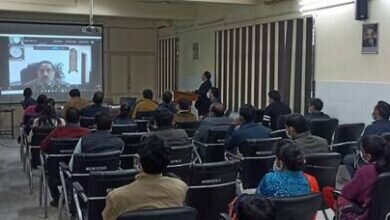Science can reign Air-pollution

Science can reign Air-pollution
A webinar on air pollution was organized by the Climate Trends, which was attended by eminent panelists including Prof S N Tripathi, Head of Civil Engineering, IIT Kanpur and Member, NCAP Steering Committee, MoEFCC, Dr V M Motghare, Joint Director – Air, Maharashtra Pollution Control Board, Ms Shloka Nath, Executive Director, India Climate Collaborative and Dr Arvind Kumar, Founder & Managing Trustee, Lung Care Foundation.
Citing the findings of IIT-K, Prof S N Tripathi said, “The findings of this multi-institutional project led to better understanding of composition, sources and pathways of Particulate Matter and its precursors like Volatile Organic Compounds and a new metric for assessment of health impacts that will help policy makers take urgent steps to mitigate the pollution sources and minimise their adverse impacts in health, ecosystem, climate and buildings.”
“These findings are pointing towards two things – the need for major reforms and the need for moving away from solid fuels. We need reforms in 3 key sectors to ensure that PM levels can come holistically across the Indo-Gangetic Plains and other hotspots in the country. Firstly, more people should be connected to the LPG scheme to move away from fossil fuels for cooking purposes. Indoor pollution will come down drastically affecting the overall particulate matter levels in the country. Secondly, we need a rapid transition towards electric vehicles to cut down vehicular emissions and thirdly, the industries need to move towards cleaner and less polluting technology. These contributions are not just state and city specific and can help in bringing down overall emissions in the country. More institutes are coming under the ambit of the National Knowledge Network to advise the State Pollution Control Boards in achieving their National Clean Air Programme targets. The two major goals for this expansion is to ensure that each supporting institute from the NKN network is working with city administrations for effective implementation of the city action plans. Secondly, these institutes will also act as auditors for the efficacy of city action plans conducted, which will be different from cities supported.”
Science can reign Air-pollution
Dr V M Motghare said, “As Navi Mumbai is growing into an industrial hub, there are instances of NOx concentrations being observed in the city. In this last week, the Maharashtra Pollution Control Board (MPCB) has signed an MoU with IIT Kanpur to install low cost sensor-based monitoring across 15 locations in the Mumbai Metropolitan region. This project will be initiated from 1 November 2020 and will be wrapped up by 31 May 2021. We have also signed MoUs with USEPA, Japan and MIT for this network installation. This technological innovation can help us identify the minutest data towards understanding and identifying hotspots and possible sources in the state and their associated health impacts.”
Putting her view, Ms Shloka Nath said, “India faces two challenges in monitoring. Firstly, we need a much wider network of air quality monitoring and secondly, we don’t know how to use this data constructively. Studies by Urban Emissions and other experts claim that India needs almost 4000 monitors to bridge the data gap. Currently the monitors are unevenly placed in urban areas, which means that our understanding of rural air pollution is even more limited. The current monitoring requirement will cost the country Rs 10,000 crore, while the entire NCAP budget is only a part of it. This does not include expenses for other activities required for air pollution management in the country. The recent analysis of city action plans by Council for Energy Environment and Water (CEEW) shows that cities are mainly submitting a laundry list of actions to meet their NCAP targets. These are not thought through with effective control measures of sources causing that pollution.”
Science can reign Air-pollution
Dr Arvind Kumar said, “Last couple of months have witnessed an improvement in cases of asthamtic patients around the country. Unfortunately this will be temporary as sources of pollution resume. But the clean air and blue skies during lockdowns have shown what is possible. Air pollution and COVID has been an area of concern. There are over 12 studies which have all clearly linked the two and the most notable is the Italian study which has done a heat mapping and covid mapping of cases across the country where incidences of higher PM levels coincide with more complicated and serious COVID cases and higher mortality. PM2.5 acts as a carrier for these virus particles. If your lungs have been affected by air pollution over the years, you are at a higher mortality risk. The weakest community will bear the brunt of this exposure. In the US we see that the African-Amircan community is far more affected than others. Similarly, in European countries the majority of deaths amongst health care workers is in the immigrant community.”
Science can reign Air-pollution
“Health advisories on air pollution are extremely important. They can be of two kind. Firstly we inform of the average pollution level and associated activities which can be undertaken or not. Secondly, based on what Prof Tripathi’s studies are trying to achieve. A more informed advisory on real time data of source apportionment, assessing the toxins and its associated health advice. For eg, if the pollutants are mainly coming from vehicular sources, then we need urgent action on that front. With good real time data being provided, the health department can be brought in to educate the public accordingly in simple ways.”
Aarti Khosla, Director, Climate Trends said, “This new research on air pollution of Delhi, led by IIT Kanpur, provides seamless and the most up to date information on the sources of pollution. From transport and construction, to crop burning, firecrackers and industry, the studies give a detailed account of contribution from each source. Such granular information should now help to clearly define the health impacts of these toxic elements for citizens in the entire region. Policymakers have no reason to not take these findings into account for air pollution management. The study has revealed that Delhi’s air contains so much pollutants including elements like Lead, Chlorine, Nickel, Chromium, and compounds like ozone, oxides of nitrogen and sulphur that solutions like smog towers and smog guns are misdirected in utilising resources which will not result in bringing down levels. The lockdown showed the dramatic effect of shutting down sources in bringing about clean air and blue skies in a short span of 74 days. While lockdowns are not the prescribed way forward, state and central governments have to plan a phasedown trajectory of big sources like fossil fuel emitters and create sustainable municipal solutions.”






